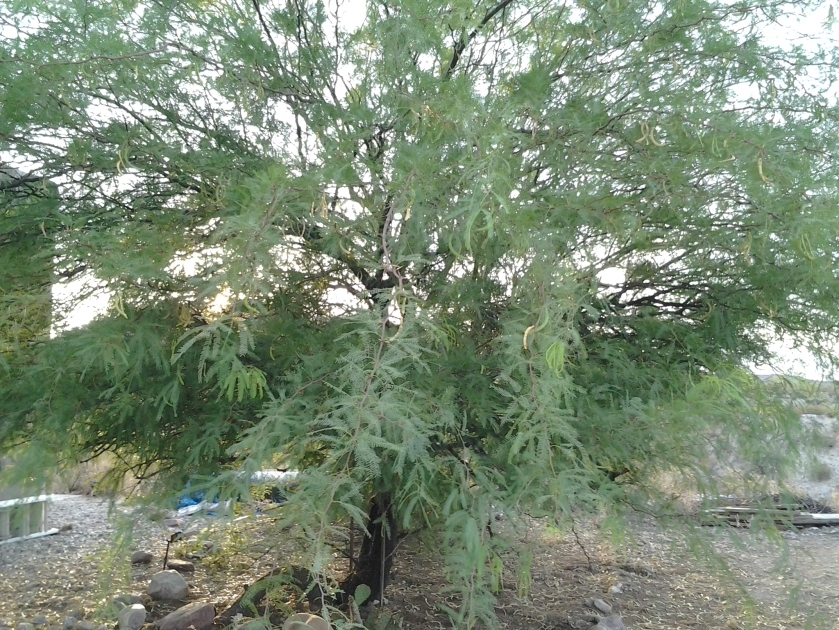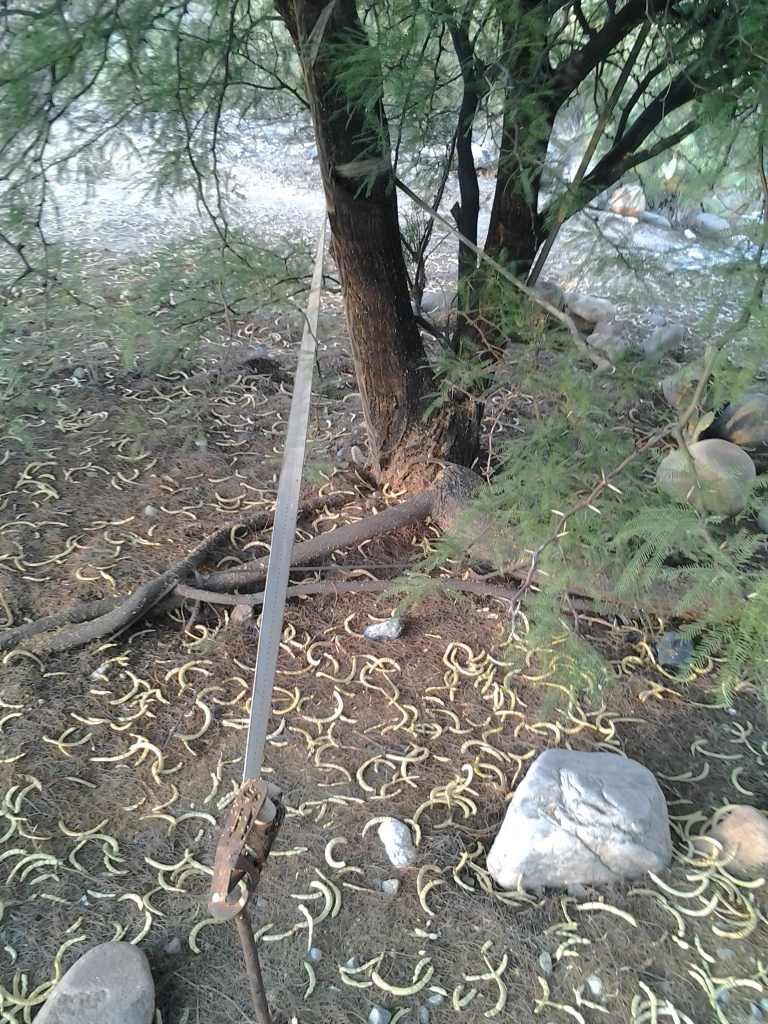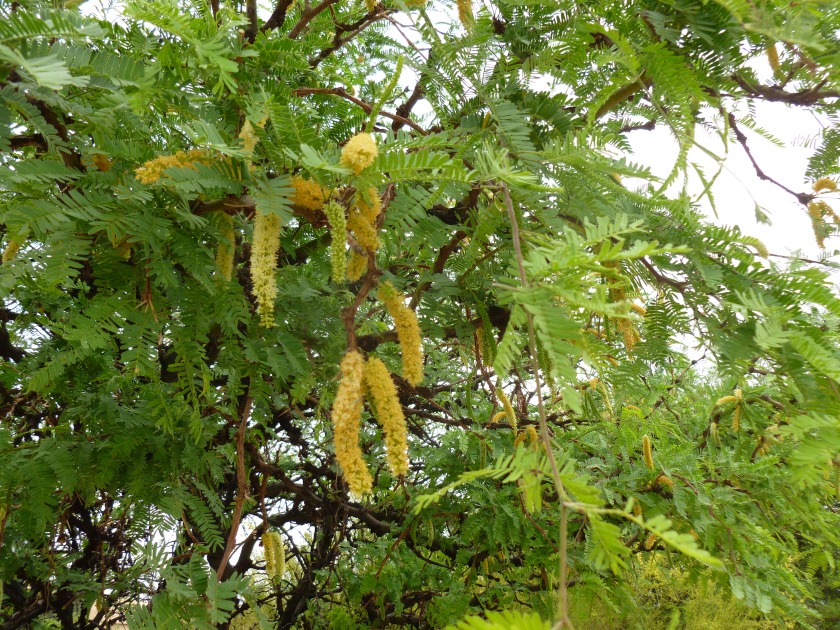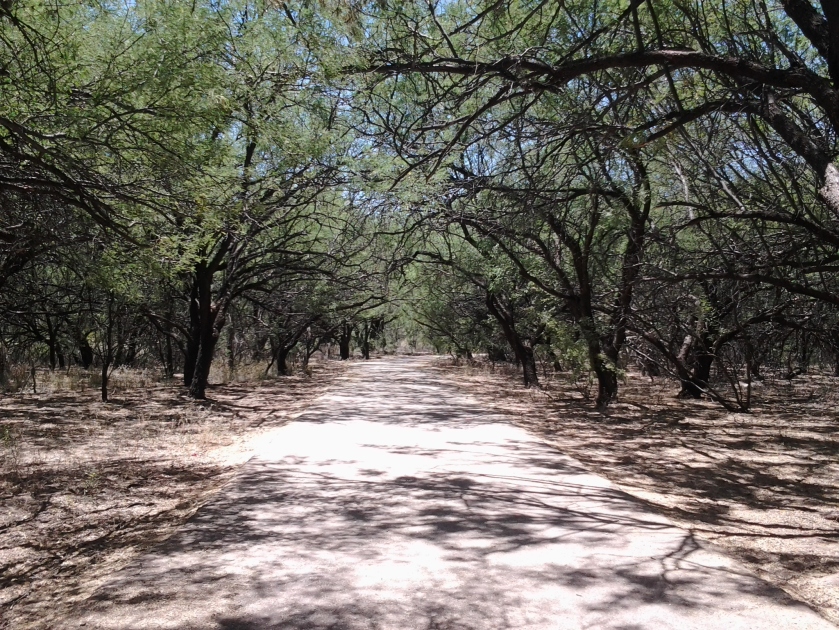Honey and Velvet Mesquite Trees can take the extreme heat and the cold! This tree grows fast. What is the most common tree of the Desert Southwest? It is the Mesquite! Like many members of the Legume Family, mesquite trees restore nitrogen to the soil.

There are 3 common species of NATIVE mesquite trees: Screwbean Mesquite (Prosopis pubescens ), Honey Mesquite (Prosopis glandulosa), and Velvet Mesquite (Prosopis velutina).

These native trees are extremely drought tolerant. Honey Mesquites are more rounded with big, floppy, drooping branches. The foliage is feathery and straight – paired with sharp spines on twigs.

This tree normally reaches 20–30 ft, but can reach as tall as 50 ft (15 m). The growth rate is medium. Honey mesquite coppices (it will make new growth from a root or stump if it is cut down), making permanent removal extremely hard. If a single trunk is cut down the Honey Mesquite will replace it with a multiple trunk version.

The Honey Mesquite has pale, yellow, elongated spikes and bears straight, yellow seed bean pods. In this picture you can see how long and strong this mesquite’s spikes are. I’ve learned NOT to wear flip-flops when walking around our Honey Mesquite!
Caring for mesquite trees is a simple process after the tree has fully matured. Mesquite trees need a full day’s worth of direct sun light to grow. Make sure to plant your mesquite tree in a place where it will always have a lot of quality sun.
Good staking is crucial to the mesquite tree, especially in areas with severe summer storms, monsoon season, or high winds.

The shade from these native Arizona trees create a 10-15 degree cooler temperature!

The shortcoming of a Chilean or Honey Mesquite tree is wind damage. Proper staking and proper watering can help you avoid wind damage with your mesquite trees.

Make your Mesquite trees “seek out” water and nutrients by careful arrangement of your irrigation emitters and scheduled DEEP irrigation. This will develop a more dispersed root system and reduces the risk of wind throw.
Pruning will keep your tree from becoming messy, while stimulating new growth on those branches that you pruned. The dead, diseased, broken or weak branches, drain the Mesquite tree’s energy.
Mesquite bean pods are rich in carbohydrates and have very low moisture content, making them an excellent source for harvesting, processing, and storage. A variety of animals eat the seeds such as quail, dear, javelina, coyotes, squirrels and rats.
Historic records have indicated that almost every part of the mesquite tree has a use. The Pima Indians of southern Arizona referred to the mesquite as the TREE OF LIFE.

During the inevitable droughts and deprivations of desert frontier days, the mesquite trees served up the primary food source for caravans and settlers. Mesquite beans became manna from heaven.
Medical studies of mesquite trees and other desert foods, said that despite its sweetness, mesquite flour (made by grinding whole pods) is extremely effective in controlling blood sugar levels in people with diabetes.
Mesquite trees have lateral roots that extend far beyond the canopies of the plants and tap-roots that penetrate well below the surface of the soil. Some mesquites may live for more than two centuries; according to U. S. Department of Agriculture, Forest Service.
(Prosopis Velutina) Velvet Mesquite is the most common of the North American varieties, it ranges from southern Arizona, southwestern New Mexico, and most common to the Chihuahua and Sonoran deserts of Mexico.

Velvet Mesquite Trees are a deciduous plant that benefits by being able to retain moisture during the winter or exceptionally dry seasons better because water does not escape through the leaves. These Mesquite trees have elongated bean pods that are sweet to taste when ripe ( reddish-yellow color). This native tree has thorns with varying lengths even on the same branch.

For the first year, deeply water your mesquite tree every week or so until it has properly matured. Once your velvet mesquite tree has matured, it can survive with a little supplemental water in addition to natural rain. In case of droughts, do water your mesquite trees more often.
Velvet Mesquites hold the record for deepest root (160′); these tap-roots can tap into deep, underground water supplies that aren’t available to the average plant.
The seeds of mesquite trees need to be scarified (abraded in flash flood or digestive tract) to germinate. Coyotes, and other desert animals eat the bean pods regularly.


I have several native mesquite trees on my property. I intend to keep them but will keep them trimmed for a more aesthetic appearance. I’m wondering if there is a way to prevent the new sprouts from developing on the branches? It seems as soon as I’m done trimming them all, I have to start again because of the new shoots starting…..
LikeLike
Mesquites are amazing trees. You will have to continue your trimming unless you cut the entire branch off at the trunk. They love to grow and keep us busy!
LikeLike
I live in Thailand & would like to grow mesquite here for the wood for my BBQ & smoker.
I am at 16.5 N latitude & in this part of Thailand it is dry from November to usually June or July. I think they would grow here. Would you agree?
If so, where could I get some seeds that are ready for planting?
Tom
LikeLike
Tom you have a monsoon season that is very similar to the Arizona monsoon, correct? You are right that mesquites should do well there. Here is a link for mesquite seeds Amazon Mesquite Tree seeds
Hope this helps!
LikeLike